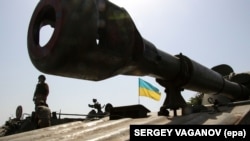On May 24, the Kyiv Court of Appeals released Volodymyr Zamana, the former Chief of the Ukrainian armed forces’ General Staff, who had been arrested for high treason on February 25 and was ordered to be held in custody until June 17.
During a press conference held on May 28, Zamana’s lawyer, Oleg Zhivotov, spoke on the case against his client. While criticizing the conclusion reached by the state's commission of experts appointed by the Prosecutor General’s Office for Zamana’s case, Zhivotov claimed the commission had determined that the Ukrainian military’s actions in eastern Ukraine are illegal.
“The experts found that, according to Article 17 of the Constitution of Ukraine, the Armed Forces of Ukraine cannot be involved in any conflict within the country. They are intended only to repel external aggression,” Zhivotov said.
Russian media seized on Zhivotov’s comments.
Zhivotov’s claim, however, is false.
Dmytro Koval, Associate Professor and Program and Legal officer at the National University of Kyiv-Mohyla Academy, said it was “impossible to verify” Zhivotov's reading of the conclusion reached by the state commission of experts appointed by the prosecutor in Zamana's case, without seeing the commission’s report.
However, he told Polygraph.info that any interpretation of Article 17 of Ukraine’s constitution claiming the military can only be used to “repel external aggression” is incorrect.
“[Article 17 of the Constitution of Ukrainian] simply doesn't say a word about expelling external aggression,” Koval said. “Moreover, article 1-1 of this law explicitly allows the use of the armed forces in the situation of peace.”
Based on the text of the Ukrainian constitution translated for the World Intellectual Property Organization, Koval is correct.
Article 17 reads:
To protect the sovereignty and territorial indivisibility of Ukraine, and to ensure its economic and informational security are the most important functions of the State and a matter of concern for all the Ukrainian people.
- The defense of Ukraine and the protection of its sovereignty, territorial indivisibility and inviolability, are entrusted to the Armed Forces of Ukraine.
- Ensuring state security and protecting the state border of Ukraine are entrusted to the respective military formations and law enforcement bodies of the State, whose organization and operational procedure are determined by law.
- The Armed Forces of Ukraine and other military formations shall not be used by anyone to restrict the rights and freedoms of citizens or with the intent to overthrow the constitutional order, subvert the bodies of power or obstruct their activity.
- The State ensures the social protection of citizens of Ukraine who serve in the Armed Forces of Ukraine and in other military formations as well as of members of their families.
- The creation and operation of any armed formations not envisaged by law are prohibited on the territory of Ukraine.
- The location of foreign military bases shall not be permitted on the territory of Ukraine.
Bogdan Bondarenko, an expert on constitutional law, legislature and elections at the Center of Policy and Legal Reform, a Ukrainian non-governmental think tank, said in the case of war, the armed forces can be used on the territory of Ukraine.
Bondarenko said Article 17 is intended to keep the military from being used against the citizens or for overthrowing the government.
“Cases of use of armed forces in peacetime are regulated by special legislation. In the context of the war on the territory of Ukraine, there are many legislative problems, but this is a bit of a different problem,” Bondarenko said.
He added that problem was “partly solved” on January 18, 2018, when the Ukrainian parliament adopted a law describing the Donetsk and Luhansk regions as “temporarily occupied” by Russia, which is designated as an “aggressor country.”
The bill is intended to help Ukraine reestablish control over those regions, while Moscow said it amounted to “preparation for war.”
Volodymyr Fesenko, head of the Penta research center, an independent Kyiv-based think-tank, told the Associated Press that bill was primarily intended to defend Ukraine’s interests in international courts.
As posited in that legislation, Ukrainian military forces in eastern Ukraine are being used to repel external aggression, as the Russian military has been deployed there, despite the Kremlin’s claims to the contrary.
As Polygraph.info previously noted, in spite of numerous denials, the evidence of Moscow’s involvement in the Donbas war is overwhelming and has been confirmed by numerous open-source investigations, journalistic investigations by international and Russian media outlets, and even, at times, by Russian officials.
Key examples include:
- The presence of Russian military equipment in eastern Ukraine neither produced by nor purchased by the Ukrainian armed forces, such as the T-90A main battle tank;
- The "continued access the “separatists” have to large quantities of advanced military technology and the ammunition, fuel, and spare parts to operate them;
- A Vice News report that proved the presence of Russian servicemen from the 37th Motorized Infantry Brigade (Kyakhta) operating in eastern Ukraine. Later, Russia adopted an “anti-selfie soldier law" which might have prevented such public evidence;
- A wealth of open source intelligence (OSINT) produced by groups such as Bellingcat and Inform Napalm demonstrating Russian military movements in Ukraine.
- On May 24, 2018, the Dutch Joint Investigative Team (JIT) presented its findings on the system that shot down the Malaysian passenger airliner MH17, which was flying over eastern Ukraine en route from Amsterdam to Kuala Lumpur. The JIT determined the missile system had been provided from Russia and identified the military unit it belonged to – the Russian armed forces’ 53rd anti-aircraft missile brigade.
Polygraph.info therefore finds the claim that Article 17 of the Ukrainian constitution bans the use of the armed forces within the country is false.








